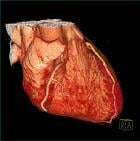
Coronary CT angiography (CCTA).
September 14, 2009 - Coronary computed tomography angiography (CCTA) enables cardiac morphology with high and isotropic spatial resolution, according to a new study published in Journal of the American College of Cardiology, Volume 54, No. 13. September 22, 2009.
Cardiac CT, although mainly used to visualize the coronary arteries after intravenous contrast injection and detect or rule out coronary artery stenoses (coronary computed tomography angiography [CTA]), also allows visualization of cardiac morphology with high and isotropic spatial resolution.
In datasets acquired for coronary artery visualization, information on the structure and, in some cases, function of the entire heart is contained. The authors of this retrospective analysis of a large cohort who underwent coronary CTA found that cardiac pathology unrelated to coronary atherosclerosis could be identified in up to 5 percent of cases. Therefore, coronary CTA datasets should be thoroughly evaluated for noncoronary cardiac findings.
Reference: Thomas Knickelbine, John R. Lesser, Tammy S. Haas, Eric R. Brandenburg, B. Kelly Gleason-Han, Bjo¨rn Flygenring, Terrence F. Longe, Robert S. Schwartz, Barry J. Maron, Identification of Unexpected Nonatherosclerotic Cardiovascular Disease with CCTA. Journal of the American College of Cardiology. Volume 54, No. 13. September 22, 2009.
For more information: content.onlinejacc.org


 August 09, 2024
August 09, 2024 








